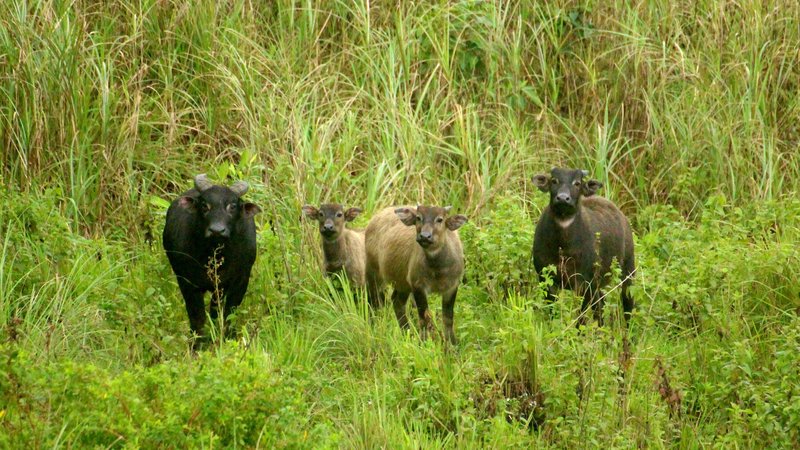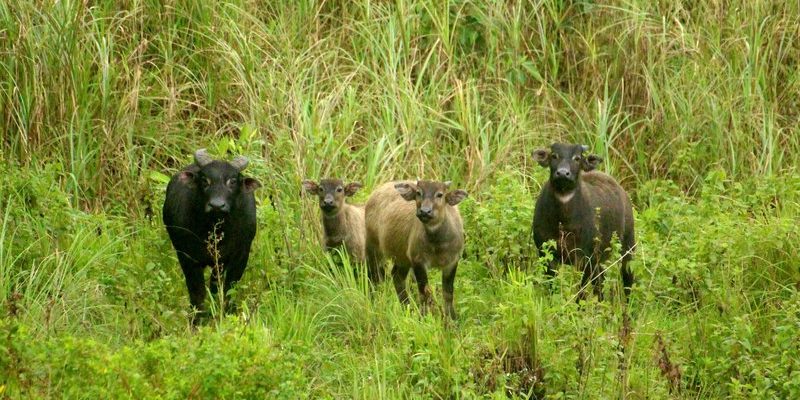
The Tamaraw is a unique and fascinating creature that captures the hearts of wildlife enthusiasts. Imagine a small, stocky water buffalo roaming the lush landscapes of the Philippines. This intriguing animal represents not just a species, but a vital piece of the biodiversity puzzle in its natural habitat. Despite its tough exterior, the Tamaraw faces critical challenges, making it a symbol for conservation efforts.
As one of the rarest large mammals in the world, the Tamaraw is a cautious herbivore, often found in hilly and mountainous regions. You might be surprised to learn that this elusive animal is endemic to the island of Mindoro. It’s like a diamond in the rough, shining brightly amidst threats from habitat loss and poaching. Understanding the Tamaraw’s way of life provides insight into the delicate balance of ecosystems.
Physical Characteristics
The Tamaraw is easily recognizable due to its distinctive features. Standing around 4 to 5 feet at the shoulder and weighing between 500 to 1,000 pounds, it’s smaller than its better-known cousin, the Asian water buffalo. The Tamaraw has a robust build with a thick, stocky body, short legs, and a wide, flat head adorned with unique, curved horns that can grow up to 28 inches long. These horns are not just for show; they serve as important tools for defense against predators.
Its coat is short and coarse, typically a dark brown or black color, which helps it blend into the dense forests where it resides. This camouflage is crucial for avoiding detection by both predators and poachers. The Tamaraw’s large, expressive eyes enhance its ability to spot danger in its surroundings—nature’s way of ensuring that this herbivore remains as elusive as possible.
Habitat of the Tamaraw
The Tamaraw calls the steep mountains and grasslands of Mindoro its home. It thrives in tropical forests, particularly in areas with dense vegetation and ample water sources. These habitats not only provide food but also vital cover from threats. Interestingly, the Tamaraw prefers open grasslands or clearings within forests, where it can graze on various plants, leaves, and grasses.
As human activity encroaches into its natural territory, the Tamaraw’s habitat has significantly shrunk. Logging, agriculture, and urban development have fragmented the land, making it challenging for these creatures to find safe areas to live. This habitat loss is one of the primary reasons the Tamaraw is currently listed as critically endangered. Restoration efforts are underway, but the fight to preserve their environment is ongoing.
Diet and Feeding Habits
Tamaraws are herbivores, meaning their diet consists mainly of plant material. They have a diverse palate that includes grasses, leaves, and shrubs. Unlike some grazing animals that prefer open fields, Tamaraws often forage in dense vegetation, taking advantage of their robust build to navigate through thickets.
One fascinating behavior is their selective feeding. Tamaraws tend to choose plants that are higher in nutritional value, a strategy that assists them in maintaining their energy in a challenging ecosystem. This selectivity means that their grazing can significantly influence the vegetation in their habitat. For example, by favoring certain plant species, they may help control plant growth and maintain biodiversity.
Reproduction and Life Cycle
The Tamaraw has a relatively slow reproductive rate, which contributes to its vulnerability. Females typically reach sexual maturity around three years of age, and they usually give birth to a single calf after a gestation period of about 300 days. The calves are born small, weighing around 20-30 pounds, and are heavily reliant on their mothers for protection and milk during the first few months of life.
Mother Tamaraws are very protective of their young, teaching them survival skills and how to forage in their environment. The bond between mother and calf is crucial for the young Tamaraw’s development. Unfortunately, due to habitat loss and poaching threats, the chances of survival for these calves are decreasing, highlighting the urgency of conservation efforts.
Conservation Status
Today, the Tamaraw is critically endangered, mainly due to habitat destruction, hunting, and poaching. With less than 400 individuals estimated to be left in the wild, the Tamaraw faces a grim future if immediate action isn’t taken. Conservation groups are working tirelessly to implement strategies for protecting their remaining population and habitat.
Efforts include habitat restoration, community education, and law enforcement to combat poaching. Local communities are encouraged to participate in conservation initiatives, recognizing that preserving the Tamaraw’s habitat can benefit them as well. It’s a collaborative effort, where understanding and appreciation for wildlife can lead to long-term success for the Tamaraw and its ecosystem.
Tamaraw Behavior and Social Structure
Tamaraws are generally solitary animals, though they can occasionally be seen in small groups or family units. As herbivores, their social interactions primarily revolve around foraging and mating. When they do gather, it’s often to rest in shaded areas during the heat of the day or when mothers are caring for their young.
These animals communicate through a mix of vocalizations, body language, and scent marking. Vocal sounds are typically low and can vary depending on the situation. For instance, a mother might use softer sounds to call her calf, while alarm calls could be louder to alert others of potential danger.
Interesting Facts About the Tamaraw
| Scientific Name: | Bubalus mindorensis |
| Size: | 4-5 feet tall at the shoulder |
| Weight: | 500-1,000 pounds |
| Diet: | Herbivore (grasses, leaves, shrubs) |
| Lifespan: | Up to 20 years in the wild |
| Habitat: | Tropical forests in Mindoro, Philippines |
Why the Tamaraw Matters
The Tamaraw is more than just a unique animal; it’s a crucial part of the ecosystem in Mindoro. As a herbivore, it plays a significant role in shaping the vegetation of its habitat. By grazing, Tamaraws help maintain the balance of plant species, which in turn supports other wildlife. If the Tamaraw were to disappear, we could see rapid changes in the ecosystem, potentially leading to the decline of other species.
Additionally, the Tamaraw serves as a symbol for conservation efforts in the Philippines. Protecting this unique animal encourages broader wildlife preservation initiatives, ultimately fostering an appreciation for the Philippines’ rich biodiversity. It’s about creating a better future—not just for the Tamaraw but for all creatures that share its home.
FAQ
What is the main threat to the Tamaraw?
The primary threat to the Tamaraw is habitat loss due to agriculture, logging, and urban expansion. These activities fragment their living space, making it challenging for them to find food and shelter. Additionally, poaching poses a significant risk, as their horns and body are often sought after, further diminishing their numbers.
How can I help conserve the Tamaraw?
You can support Tamaraw conservation efforts by donating to wildlife preservation organizations, spreading awareness about the species, or even visiting Mindoro to engage in eco-tourism responsibly. Every little action helps raise awareness and funds for their protection!
Are Tamaraws social animals?
Tamaraws are primarily solitary creatures, though they may occasionally be seen in small groups or family units. Their interactions are often limited to foraging or caring for young. This solitary behavior helps reduce competition for food and minimizes stress.
What is the size of a Tamaraw?
An adult Tamaraw typically stands about 4 to 5 feet tall at the shoulder and weighs between 500 to 1,000 pounds. Despite being smaller than other buffalo species, their solid build and distinctive features make them easily recognizable.
Where do Tamaraws live?
Tamaraws are endemic to the island of Mindoro in the Philippines. They inhabit tropical forests and hilly areas, often choosing regions with dense vegetation for shelter. Protecting these habitats is crucial for their survival.
How long do Tamaraws live?
In the wild, Tamaraws can live up to 20 years, although their lifespan can be reduced due to environmental challenges and threats from poaching. Conservation efforts aim to improve their chances of survival, ensuring they can thrive for generations.
What do Tamaraws eat?
Tamaraws are herbivores, primarily feeding on grasses, leaves, and shrubs. Their selective eating habits allow them to thrive in their habitat, but it also means they can be affected by changes in vegetation due to habitat loss.
What conservation efforts are in place for the Tamaraw?
Various organizations and government initiatives focus on protecting the Tamaraw through habitat restoration, anti-poaching laws, and community education programs. These efforts aim to create a sustainable environment where Tamaraws can flourish alongside local communities.
Are Tamaraws related to other buffalo species?
Yes, Tamaraws belong to the same family as other buffalo species, such as the Asian water buffalo. However, they are distinct in terms of size, habitat preference, and behavior, showcasing the diversity within the buffalo family.
Why are Tamaraws important to their ecosystem?
Tamaraws play a vital role in their ecosystem by influencing the vegetation through their grazing habits. By maintaining the plant diversity, they support other wildlife and contribute to the overall health of their habitats, making them crucial for ecological balance.

